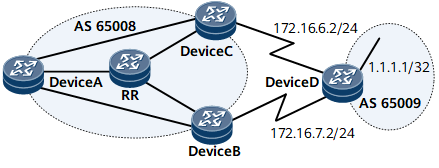Configuring BGP Add-Path
BGP Add-Path allows a route reflector (RR) to send two or more routes with the same prefix to a specified IBGP peer. These routes can back up each other or load-balance traffic, which improves network reliability.
Usage Scenario
In a scenario with an RR and clients, if the RR has multiple BGP routes to the same destination (with the same prefix), the RR selects an optimal route from these routes and then sends only the optimal route to its clients. Therefore, the clients have only one route to the destination. If a link along this route fails, route convergence takes a long time, which cannot meet the requirements for high reliability.
To address this issue, deploy the BGP Add-Path feature on the RR. With BGP Add-Path, the RR can send two or more routes with the same prefix to a specified IBGP peer. These routes can back up each other or load-balance traffic, which ensures high reliability in data transmission. The BGP Add-Path feature does not affect BGP route selection rules.

The RR can send Add-Path routes only to IBGP peers.
BGP Add-Path is not supported in BGP confederation scenarios.
Enable BGP Add-Path on the RR, enable the RR to send Add-Path routes to a specified IBGP peer, configure the number of routes that the RR can send to the IBGP peer, and enable the IBGP peer to receive BGP Add-Path routes from the RR so that such routes are available to the IBGP peer. In Figure 1, you can enable BGP Add-Path on the RR, enable Device A to receive BGP Add-Path routes from the RR so that Device A can receive two routes destined for 1.1.1.1/32, with next hops of 172.16.6.2 and 172.16.7.2. The two routes can back up each other or load-balance traffic.
Checking the Configurations
Run the following commands on the RR to check configurations:
- Run the display bgp peer verbose command to check information about BGP Add-Path.
